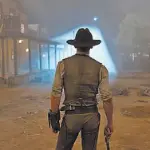Like many others, I was initially attracted to this film to admire Maggie Cheung gracefully walking in various cheongsams. Yet, as I watched, I found the repeated shots of her more than just visually striking - they are a vibrant splash of color in the film. Like the film's haunting cello score, these images highlight a theme: the most beautiful times juxtaposed with the worst love.
Set in Hong Kong's 1960s middle-class milieu, the film tells a simple story of an extramarital affair. Reminiscent of the American film "The Bridges of Madison County," it offers a similar depth of emotion but from an Eastern perspective, reflecting the subdued sorrow of that era's white walls and black tiles.
Director Wong Kar-wai, often seen in his signature sunglasses, is known for his strong personal style, as seen in films like "Days of Being Wild," "Chungking Express," and "Ashes of Time." Even his controversial film on homosexuality, "Happy Together," is delicately crafted. However, "In the Mood for Love" (2000) diverges from Wong's avant-garde aesthetic. Instead, it's filled with subtlety and implicit visual language, conveying a uniquely Eastern ethos and beauty. It's a Wong Kar-wai film that departs from his usual style yet profoundly embodies his sensibilities.

Tony Leung and Maggie Cheung portray Chow Mo-wan and Su Li-zhen, a pair of traditional, married individuals from Hong Kong's 1960s middle class. By chance, they become neighbors. Their interactions start cordially but soon uncover the infidelity of their respective spouses. This revelation draws them closer, whether out of empathy or revenge or simply seeking a confidante. They dine together, co-write a martial arts novel, and reenact their partners' infidelity, but their relationship remains platonic, underscored by the phrase, "We won't be like them." Yet, as they grow closer, an unspoken love develops.
The film is heavy and thought-provoking. Many may watch it for its gorgeous cheongsams, which indeed are a delight. But to view it merely for its costumes is to undervalue its depth. The film, like a cup of tea, reveals its intricate flavors upon closer inspection, from its detailed close-ups and the soft glow of yellow streetlights in the rain to the vivid color palette and striking compositions. The sound design is equally compelling, with even the raindrops resonating powerfully. The melancholic yet restrained violin score accompanying the protagonists' encounters is particularly memorable.

One memorable scene is Chow eating wonton noodles alone, his loneliness palpable. Su's appearance, shown from the hands up but never revealing her face, leaves much to the audience's imagination. Their separate struggles with unfaithful spouses are subtly contrasted, highlighting two different perspectives on love.
Another poignant moment is when Chow finally confesses his feelings to Su, who responds with silence, signifying the impossibility of their relationship. In an exercise of rejection, Su agrees to help Chow practice facing rejection. The close-up of Su's hand spasming as Chow releases it, followed by her gripping her arm, vividly conveys her inner turmoil without a word being spoken. The scene culminates in Su crying on Chow's shoulder, a powerful yet understated portrayal of pent-up emotions.
In the end, Chow leaves Hong Kong, and Su visits his empty room, smoking a cigar for the familiar scent instead of for the sake of smoking. Her tears flow freely, mirroring the film's quiet yet profound impact. This is a film that rewards repeated viewings, revealing its layered beauty and complexity with each watch.

"In the Mood for Love" is a film that lingers, its themes of unspoken love and missed opportunities encapsulated in the phrase, "If there was one more ticket, would you come with me?" It's a film about the love that exists in moods and moments, lost in the fleeting beauty of youth.

























































Share your thoughts!
Be the first to start the conversation.